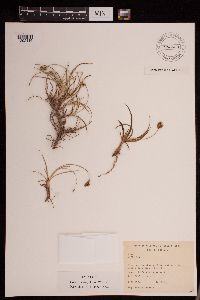Cyperaceae taxon details
Carex ownbeyi G.A.Wheeler
1676674 (urn:lsid:marinespecies.org:taxname:1676674)
accepted
Species
terrestrial
Wheeler, G. A. (2002). Carex (Cyperaceae) from South America: three new species and some name changes. <em>Darwiniana.</em> 40: 199-208., available online at https://www.jstor.org/stable/23225174
page(s): 200 [details] Available for editors [request]
[request]
page(s): 200 [details] Available for editors
Holotype MIN
953616, geounit Bolivia
953616, geounit Bolivia
Holotype MIN
953616, geounit Bolivia [details]
953616, geounit Bolivia [details]
Description Loosely cespitose from brown, prolonged rhizomes. Fertile culms 12–22 cm tall, 0.5–0.8 mm thick, usually slightly to...
Taxonomic remark Source in seed data: wcs Updated namePublishedIn from Darwiniana 40: 200 2002 to Darwiniana 40(1-4): 200 (2002). ,...
Description Loosely cespitose from brown, prolonged rhizomes. Fertile culms 12–22 cm tall, 0.5–0.8 mm thick, usually slightly to strongly curved, trigonous, smooth proximally and finely scabrous-angled distally (especially beneath the inflorescence), with glabrous, brownish basal sheaths. Leaves 3–5, on lower one-fourth of culm; blades 2–10 cm long, 1.2–2.5 mm wide, plicate, glabrous, the margins antrorsely scabrous distally; leaf sheaths 2–15 mm long, tightly enveloping culms, glabrous; the inner band of sheaths glabrous, white-hyaline or pale brown, the apex nearly straight across; ligules 0.7–1.4 mm long, slightly wider than long, rounded, the narrow free portion brownish. Inflorescences 1–1.5 cm long, 5–8 mm wide, the spikes aggregated into a terminal, ovoid or oblong head; bracts shorter than the inflorescence, the lowermost scale-like with bodies 2.5–5 mm long and 1.6–2.4 mm wide, ovate-lanceolate, acute, with serrulate awns up to 3 mm long, the upper ones reduced. Spikes 3–6, androgynous, 5–7 mm long, 3.5–6 mm wide, ovoid, mostly distinguishable but the apical staminate flowers inconspicuous (except for the anthers), perigynia 4–9 per spike. Pistillate scales 2.6–4.2 mm long, 1.4–2 mm wide, shorter than the perigynia, ovate to broadly ovate, acute or mucronate, reddish brown with a stramineous or pale brown center and with or without narrow hyaline margins, 1–3-veined; staminate scales similar but smaller. Perigynia 3.5–4 mm long, 1.2–1.9 mm wide, ascending, plano-convex with ovate or oblong-elliptic sides, the margins smooth except sometimes scaberulent at the shoulders, greenish or pale brown proximally and often reddish brown distally, glabrous, subcoriaceous, 2 lateral veins prominent and finely but distinctly 6–10-veined abaxially and 3–7-veined adaxially, substipitate, more or less tapered into a beak; beaks 0.7–1 mm long, the margins serrulate, the apex bidentulate with teeth up to 0.2 mm long. Achenes 2–2.5 mm long, 1.3–1.5 mm wide, lenticular, ovate-oblong, brown except for a whitish stipe 0.1–0.3 mm long. Stigmas 2. Anthers 3, 1.8–2.2 mm long, including a slender apical appendage 0.1–0.2 mm long. [details]
Taxonomic remark Source in seed data: wcs Updated namePublishedIn from Darwiniana 40: 200 2002 to Darwiniana 40(1-4): 200 (2002). ,...
Taxonomic remark Source in seed data: wcs Updated namePublishedIn from Darwiniana 40: 200 2002 to Darwiniana 40(1-4): 200 (2002). , according to IPNI. Information provided by Alan E. on email Jul. 15 2020. More details could be found in [details]
Cyperaceae Working Group. (2025). [see How to cite]. Global Cyperaceae Database. Carex ownbeyi G.A.Wheeler. Accessed at: https://www.cyperaceae.org/aphia.php?p=taxdetails&id=1676674 on 2025-09-12
Date
action
by
2024-12-10 11:47:54Z
unchecked
db_admin
![]() The webpage text is licensed under a Creative Commons
Attribution 4.0 License
The webpage text is licensed under a Creative Commons
Attribution 4.0 License
Nomenclature
original description
Wheeler, G. A. (2002). Carex (Cyperaceae) from South America: three new species and some name changes. <em>Darwiniana.</em> 40: 199-208., available online at https://www.jstor.org/stable/23225174
page(s): 200 [details] Available for editors [request]
[request]
basis of record Plants of the World Online (POWO). , available online at https://powo.science.kew.org/ [details]
page(s): 200 [details] Available for editors
basis of record Plants of the World Online (POWO). , available online at https://powo.science.kew.org/ [details]
 Present
Present  Inaccurate
Inaccurate  Introduced: alien
Introduced: alien  Containing type locality
Containing type locality
From editor or global species database
Description Loosely cespitose from brown, prolonged rhizomes. Fertile culms 12–22 cm tall, 0.5–0.8 mm thick, usually slightly to strongly curved, trigonous, smooth proximally and finely scabrous-angled distally (especially beneath the inflorescence), with glabrous, brownish basal sheaths. Leaves 3–5, on lower one-fourth of culm; blades 2–10 cm long, 1.2–2.5 mm wide, plicate, glabrous, the margins antrorsely scabrous distally; leaf sheaths 2–15 mm long, tightly enveloping culms, glabrous; the inner band of sheaths glabrous, white-hyaline or pale brown, the apex nearly straight across; ligules 0.7–1.4 mm long, slightly wider than long, rounded, the narrow free portion brownish. Inflorescences 1–1.5 cm long, 5–8 mm wide, the spikes aggregated into a terminal, ovoid or oblong head; bracts shorter than the inflorescence, the lowermost scale-like with bodies 2.5–5 mm long and 1.6–2.4 mm wide, ovate-lanceolate, acute, with serrulate awns up to 3 mm long, the upper ones reduced. Spikes 3–6, androgynous, 5–7 mm long, 3.5–6 mm wide, ovoid, mostly distinguishable but the apical staminate flowers inconspicuous (except for the anthers), perigynia 4–9 per spike. Pistillate scales 2.6–4.2 mm long, 1.4–2 mm wide, shorter than the perigynia, ovate to broadly ovate, acute or mucronate, reddish brown with a stramineous or pale brown center and with or without narrow hyaline margins, 1–3-veined; staminate scales similar but smaller. Perigynia 3.5–4 mm long, 1.2–1.9 mm wide, ascending, plano-convex with ovate or oblong-elliptic sides, the margins smooth except sometimes scaberulent at the shoulders, greenish or pale brown proximally and often reddish brown distally, glabrous, subcoriaceous, 2 lateral veins prominent and finely but distinctly 6–10-veined abaxially and 3–7-veined adaxially, substipitate, more or less tapered into a beak; beaks 0.7–1 mm long, the margins serrulate, the apex bidentulate with teeth up to 0.2 mm long. Achenes 2–2.5 mm long, 1.3–1.5 mm wide, lenticular, ovate-oblong, brown except for a whitish stipe 0.1–0.3 mm long. Stigmas 2. Anthers 3, 1.8–2.2 mm long, including a slender apical appendage 0.1–0.2 mm long. [details]Taxonomic remark Source in seed data: wcs Updated namePublishedIn from Darwiniana 40: 200 2002 to Darwiniana 40(1-4): 200 (2002). , according to IPNI. Information provided by Alan E. on email Jul. 15 2020. More details could be found in [details]
To European Nucleotide Archive, ENA (Carex ownbeyi)
To GenBank (4 nucleotides; 0 proteins)
To International Plant Names Index (IPNI)
To IUCN Red List (Critically Endangered)
To Plants of the World Online
To University of Minnesota Herbarium (Carex ownbeyi MIN953616 holotype 1)
To University of Minnesota Herbarium (Carex ownbeyi MIN953633 Paratype 1)
To GenBank (4 nucleotides; 0 proteins)
To International Plant Names Index (IPNI)
To IUCN Red List (Critically Endangered)
To Plants of the World Online
To University of Minnesota Herbarium (Carex ownbeyi MIN953616 holotype 1)
To University of Minnesota Herbarium (Carex ownbeyi MIN953633 Paratype 1)





